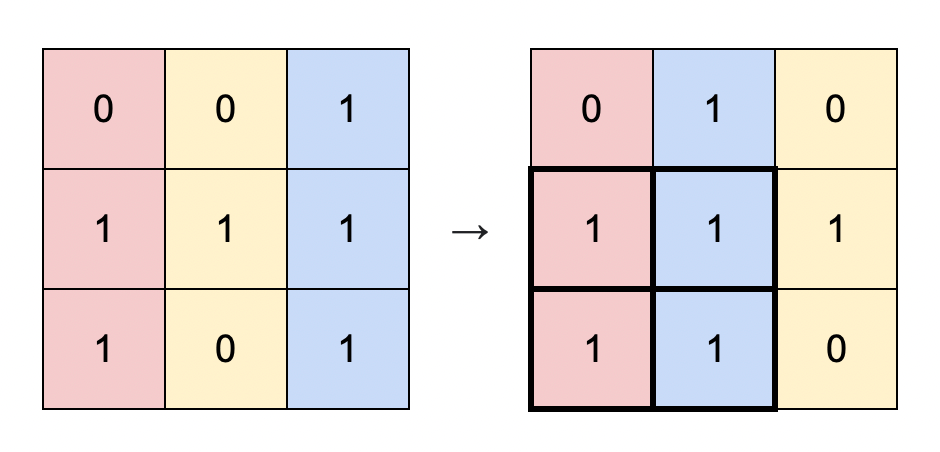1727. Largest Submatrix With Rearrangements
Description
You are given a binary matrix matrix of size m x n, and you are allowed to rearrange the columns of the matrix in any order.
Return the area of the largest submatrix within matrix where every element of the submatrix is 1 after reordering the columns optimally.
Example 1:
Input: matrix = [[0,0,1],[1,1,1],[1,0,1]] Output: 4 Explanation: You can rearrange the columns as shown above. The largest submatrix of 1s, in bold, has an area of 4.
Example 2:
Input: matrix = [[1,0,1,0,1]] Output: 3 Explanation: You can rearrange the columns as shown above. The largest submatrix of 1s, in bold, has an area of 3.
Example 3:
Input: matrix = [[1,1,0],[1,0,1]] Output: 2 Explanation: Notice that you must rearrange entire columns, and there is no way to make a submatrix of 1s larger than an area of 2.
Constraints:
m == matrix.lengthn == matrix[i].length1 <= m * n <= 105matrix[i][j]is either0or1.
Solutions
Solution 1: Preprocessing + Sorting
Since the matrix is rearranged by columns according to the problem, we can first preprocess each column of the matrix.
For each element with a value of \(1\), we update its value to the maximum consecutive number of \(1\)s above it, that is, \(matrix[i][j] = matrix[i-1][j] + 1\).
Next, we can sort each row of the updated matrix. Then traverse each row, calculate the area of the largest sub-matrix full of \(1\)s with this row as the bottom edge. The specific calculation logic is as follows:
For a row of the matrix, we denote the value of the \(k\)-th largest element as \(val_k\), where \(k \geq 1\), then there are at least \(k\) elements in this row that are not less than \(val_k\), forming a sub-matrix full of \(1\)s with an area of \(val_k \times k\). Traverse each element of this row from large to small, take the maximum value of \(val_k \times k\), and update the answer.
The time complexity is \(O(m \times n \times \log n)\). Here, \(m\) and \(n\) are the number of rows and columns of the matrix, respectively.
1 2 3 4 5 6 7 8 9 10 11 12 | |
1 2 3 4 5 6 7 8 9 10 11 12 13 14 15 16 17 18 19 20 21 | |
1 2 3 4 5 6 7 8 9 10 11 12 13 14 15 16 17 18 19 20 21 | |
1 2 3 4 5 6 7 8 9 10 11 12 13 14 15 16 17 18 | |
1 2 3 4 5 6 7 8 9 10 11 12 13 14 15 16 17 18 19 20 21 22 23 24 25 26 27 28 29 30 31 32 33 34 35 36 | |




